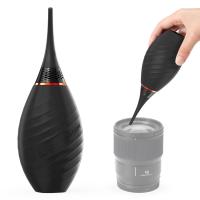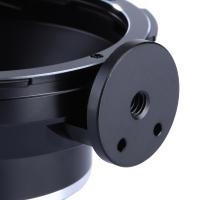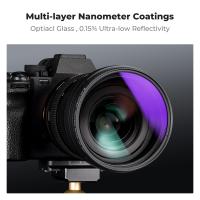Benefits Of Stained When Using A Microscope ?
Staining is a technique used in microscopy to enhance the contrast of the specimen being observed. By adding a stain to the sample, certain structures or components can be highlighted, making them easier to see and study. This can be particularly useful when observing transparent or colorless specimens.
Staining can also help to differentiate between different types of cells or tissues, as different stains will bind to different components. For example, hematoxylin and eosin staining is commonly used in histology to distinguish between different types of cells and tissues.
In addition to improving contrast and aiding in identification, staining can also help to preserve the sample. By fixing the sample with a chemical solution and then staining it, the specimen can be stored for longer periods of time without deteriorating.
Overall, staining is a valuable tool in microscopy that can help to improve the quality of observations and aid in the study of biological specimens.
1、 Improved Contrast
One of the primary benefits of staining when using a microscope is improved contrast. Staining involves adding a dye or chemical to a sample, which helps to highlight specific structures or components within the sample. This makes it easier to distinguish between different parts of the sample and can help to reveal details that might otherwise be difficult to see.
Improved contrast is particularly important when studying biological samples, as many of the structures and components within these samples are transparent or nearly transparent. By staining the sample, researchers can make these structures more visible and gain a better understanding of their function and behavior.
In addition to improved contrast, staining can also help to enhance the resolution of the microscope. This is because the dye or chemical used in staining can help to reduce the amount of light scattering that occurs within the sample. This, in turn, can help to produce sharper, clearer images that are easier to interpret.
Recent advances in staining techniques have also made it possible to study samples in greater detail than ever before. For example, new fluorescent dyes can be used to label specific proteins or molecules within a sample, allowing researchers to track their movement and behavior in real-time. This has opened up new avenues of research in fields such as cell biology and neuroscience, and has the potential to lead to new discoveries and breakthroughs in these areas.

2、 Enhanced Resolution
One of the benefits of staining when using a microscope is enhanced resolution. Staining involves adding a dye or chemical to a sample, which helps to highlight specific structures or components within the sample. This makes it easier to visualize and study these structures under a microscope.
By enhancing the contrast between different parts of the sample, staining can help to reveal details that might otherwise be difficult to see. This can be particularly useful when studying small or complex structures, such as cells or tissues. Staining can also help to differentiate between different types of cells or tissues, which can be important for identifying diseases or abnormalities.
In recent years, there has been growing interest in using new types of stains and dyes to further enhance the resolution of microscopy. For example, fluorescent dyes can be used to label specific molecules or structures within a sample, allowing them to be visualized with greater clarity. Other types of stains, such as metal stains, can be used to highlight specific elements within a sample, such as calcium or iron.
Overall, staining is an important tool for enhancing the resolution of microscopy. By highlighting specific structures and components within a sample, staining can help researchers to better understand the complex biological processes that underlie health and disease. As new staining techniques continue to be developed, it is likely that microscopy will continue to play an increasingly important role in biomedical research and clinical practice.

3、 Highlighted Specific Structures
One of the benefits of staining when using a microscope is that it highlights specific structures within a sample. Staining involves the use of dyes or chemicals that bind to specific components of a sample, making them more visible under the microscope. This allows researchers to identify and study specific structures within a sample, such as cells, tissues, or microorganisms.
Staining can also help to differentiate between different types of cells or tissues within a sample. For example, different types of cells may have different staining properties, allowing researchers to distinguish between them and study their individual characteristics. This can be particularly useful in medical research, where identifying specific cells or tissues can help to diagnose diseases or develop new treatments.
In addition to highlighting specific structures, staining can also improve the contrast and clarity of a sample under the microscope. This can make it easier to observe and study the sample, as well as to capture high-quality images for further analysis.
Recent advances in staining techniques have also led to the development of new types of dyes and chemicals that can provide more detailed information about a sample. For example, fluorescent dyes can be used to label specific molecules within a sample, allowing researchers to track their movement and interactions in real-time.
Overall, staining is an essential tool for researchers using microscopes to study biological samples. By highlighting specific structures and improving the clarity of a sample, staining can provide valuable insights into the structure and function of living organisms.

4、 Differentiation of Cell Types
One of the benefits of staining when using a microscope is the differentiation of cell types. Staining allows for the visualization of specific structures within cells, such as the nucleus, cytoplasm, and organelles. This differentiation is important in identifying and characterizing different cell types, which is crucial in fields such as pathology and microbiology.
Staining also allows for the detection of abnormalities or changes in cell structure, which can be indicative of disease or other conditions. For example, staining can reveal the presence of cancerous cells or the effects of a particular treatment on cell structure.
In recent years, there has been a growing interest in the use of fluorescent staining techniques, which allow for the visualization of specific molecules within cells. This has led to advances in fields such as neuroscience, where fluorescent staining can be used to track the movement of specific proteins or neurotransmitters within the brain.
Overall, staining is an essential tool in microscopy, allowing for the differentiation and characterization of cell types and the detection of abnormalities or changes in cell structure. With the development of new staining techniques, the potential applications of staining in research and clinical settings continue to expand.








































